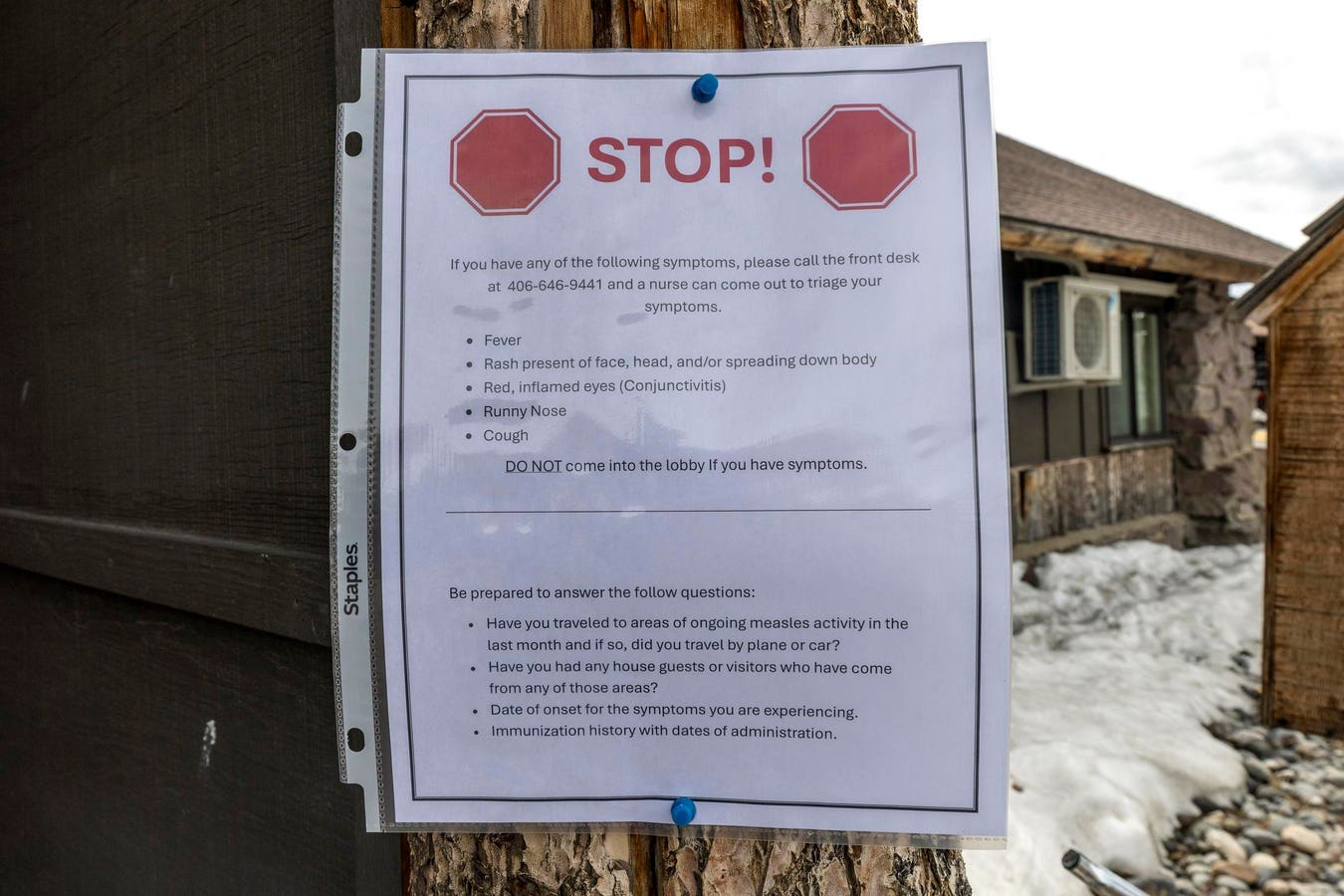As of July 29, there’s already been a total of 1,333 confirmed measles cases across 40 jurisdictions, according to CDC data. (Photo by Natalie Behring/Getty Images)
Getty Images
Childhood vaccination rates dropped even further for the 2024-2025 school year down to the lower 92% range with a record number of exemptions from vaccinations among kindergarteners, according to new data from the U.S. Centers for Disease Control and Prevention. Meanwhile, this year the U.S. has already experiencing the most measles cases and outbreaks that it’s had in years with 1,333 and 29, respectively. Gee, do you think these things are somehow connected in any way? Well, the likely answer rhymes with the word “mess.”
Childhood Vaccination Rates Have Fallen To The 92% Range
“A mess” can describe what used to be a tidy public health situation. The newest CDC data shows that measles, mumps, rubella vaccination coverage among kindergarteners continued a downward trend. Rates have dropped from 95.2% in the 2019-2020 school year down to 92.7% in the 2023-2024 school year and even further to 92.5% this past school year.
Coverage numbers for other vaccines have been going the wrong direction as well. Rates for the diphtheria, tetanus, and acellular pertussis vaccine otherwise known as the DTaP vaccine have fallen from 94.9% in 2019-2020 to 92.3% in 2023-2024 to 92.1% this past school year. Over the same time periods. the percentage of kids who got two doses of the varicella vaccine went from 94.8% to 92.3% to 92.1%. And coverage for the polio vaccine has gone from 95% to 92.7% to 92.5%.
All of this has corresponded to a rise in the number of parents seeking exemptions from vaccinations for their children, going from 2.5% in the 2020-2021 schools year to 3.3% in 2023-24 to 3.6% in 2024-25. The U.S. basically had an all-time record number of such exemptions last school year with around 138,000 children getting them for at least one vaccine.
And this isn’t an issue in just a few states painted a certain political color. The majority of states (36 of them) in the U.S. as well as the District of Columbia had increases in exemptions from the previous. In fact, 17 states saw exemption rates that went above 5%. And which state do you think had the highest rate of exemptions? It rhymes with “I don’t know.” Idaho had the highest rate at a whopping 15.4%
2025 Has Already Had 1,333 Confirmed Measles Cases, 29 Outbreaks
Meanwhile, the U.S. continues to go back in time when it comes to the measles. Measles outbreaks were very common before the arrival of the measles vaccine in the 1960s. Then over time as vaccination coverage increased, the threat of measles decreased. Once measles vaccination rates stayed above the herd immunity threshold of 95% for years, measles became rarer and rarer. That was because with such a large percentage of the population vaccinated, the measles virus had trouble finding unprotected humans to infect and treat like a cheap motel to reproduce and spread further. Eventually, the measles virus was effectively gone baby gone from the U.S., which declared measles eliminated in 2000.
How quickly people forget, though. Since 2000, persistent misinformation and disinformation about the measles vaccine have helped erode MMR vaccination rates. Over the past decade, I’ve been writing more and more about measles cases and outbreaks, like this one, in the U.S. mainly because more and more measles cases and outbreaks have been occurring. I’ve written about I wrote in Forbes in 2019 about how anti-vaxxers made that year’s World Health Organization’s list of top ten global health threats
All of this brings us to this year, which has been a great year if you are the measles virus. Not so great for many humans. As of July 29, there’s already been a total of 1,333 confirmed measles cases across 40 jurisdictions, according to CDC data. Try to find the states that are not among the following that have had reported measles cases: Alaska, Arkansas, Arizona, California, Colorado, Florida, Georgia, Hawaii, Illinois, Indiana, Iowa, Kansas, Kentucky, Louisiana, Maryland, Michigan, Minnesota, Missouri, Montana, Nebraska, New Jersey, New Mexico, New York City, New York State, North Carolina, North Dakota, Ohio, Oklahoma, Oregon, Pennsylvania, Rhode Island, South Carolina, South Dakota, Tennessee, Texas, Utah, Vermont, Virginia, Washington and Wyoming.
Oh, and measles is really contagious. Like really, really contagious. Among unvaccinated people, one case can easily lead to 12 to 18 more cases. About 87% of all reported measles cases this year have been part of outbreaks. This year has also already had 29 reported outbreaks, up from 16 in all of 2024.
Lack Of More Urgent Action
Dropping vaccination rates and rising measles cases and outbreaks should be more than a canary in a coal mine for the U.S. It should be a freaking elephant. We’ve essentially allowed a problem that was taken care of to return and potentially make America measle-ly again. Not only that. With other vaccination rates declining as well, we could see resurgences of other infectious disease as well, including polio.
Things could be reversed if prompt actions are taken to get vaccination rates back up again before the different nasty microbes can spread too far in the U.S. population. But there doesn’t seem to be an organized effort at the federal level to address these worsening problems. In fact, there are disturbing trends in the opposite direction such as the layoffs of personnel who were dedicated to help control infectious diseases, claims being made about vaccines that are unsupported by scientific evidence and cuts in funding for scientific research and public health efforts.
The CDC website still has language about vaccination being simply a personal choice. But that simply is not the case. Since the percentage of people vaccinated affects the spread of viruses and other microbes, each person’s decision to get vaccinated affects everyone else’s risk of getting the disease. Therefore, having people around you not vaccinated against say the measles raises your risk of your risk of getting the measles, even if you yourself are already vaccinated against the measles. In other words, childhood vaccinations are not simply child’s play.









